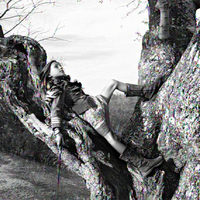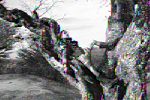 |
George Eastman Hall

upcoming
exhibition
The Exhibition EXTENDED
to
Nadja Massun
Alice in the Land of Zapata
Open to the public:
September 21 – November 4 2012
on Weekdays: 14.00 - 19.00
at Weekends 11.00 - 19.00




The person who comes from afar
I’ve heard that people from afar can say or claim whatever they want about themselves. Putting a little twist on the original saying, people can say whatever they want about a person that comes from afar. In the case of Nadja Massun, the proverb may be even truer since she does come from very far away. She lives in Mexico but was born in Africa to a Hungarian mother and a Belgian father. Her family, in fact, has had quite an adventurous life. They had to flee their villa by the Congo rain forest when, as the result of the Congolese independent leader Patrice Lumumba’s assassination, local confrontations rendered European lives worthless – and maybe those of non-Europeans as well, but that is another story.
Living the typical life of diplomatic families, by the age of two Nadja had lived in Colombia and later on had found homes in various countries from Colombia through Peru to Costa Rica. Furthermore, she also spent every summer at her grandma’s house by Lake Balaton. In the meantime, she also had found time to graduate from university. Later on she worked at the UN Refugee Agency, moved to Mexico, got married to a local painter, and gave birth to two daughters.
But why do I dwell on these biographical details for so long?
The answer is that Nadja’s photos are a reflection of the many bright moments –significant or not – that have sparked her life. For her, every photographic situation is a privileged circumstance of life, a fleeting encounter that aims at prolonging that tiny feeling, situation, mood or tone – just the way a pianist prolongs a note by pressing the pedal. The themes in her photos relate to small incidents in her daily life, involving her family, her friends, people around her and the places she lives in. However, these life moments do not turn into family photos intended to remain in a drawer. They are unique creations, filled with details worthy of attention. Obviously, Nadja Massun is no novice in her art. Since 2000 she has participated in a number of professional workshops at the Manuel Alvarez Bravo Center of Photography in Oaxaca and her work has been shown in many solo and group exhibitions.
Nadja’s images of Mexico, Morocco, and Cuba are pervaded with a sense of secrecy; this strange combination of mystical existence and her most private personality makes us fall in love with her photographs. I could say anything about these photos since this is her first exhibition in Hungary, and, you know, she is a person who comes from afar... But I am quickly pulled back to reality. It’s enough to look at Nadja’s images taken in Hungary – for example, those at the Kerepesi cemetery (National Graveyard), or in Transylvania. Not only do these images reveal that such subjects may very well be photographed without applying the filter of partisan tricolor, but they also attest to an important notion: a photo is not only and not primarily about what it shows, but rather about the person who takes it. Photos of the cemetery’s carved-stone statues are not manifestations of pathos but, rather, are works of a very delicate, sensitive woman endowed with a Latin temperament and a disposition to a genuine Eastern European melancholy. Arriving in Transylvania, she forgot about Mexico, Paris, Havana, and all superimposed cultural or other influences she was affected by during her travels from Bogotá through Oaxaca and photographed Szék (Sic, Cluj County), its inhabitants, the dance hall, or the young women on their way to church as a Hungarian would.
And - you may wonder - why is this so significant? Because Nadja Massun is able to take in, embrace, photograph, and show Transylvania as a Hungarian, Mexico as a Mexican, Cuba as a Cuban, and Morocco as an Arab. This is her most remarkable quality. Wherever she is, she will be at home; she will not be taking photos as a tourist but as a mother playing with her children, a housewife carrying groceries, or a dancer in a dance hall. What I said is only seemingly complicated. Just look at her photos and it will all become clear, understandable, livable and natural.
Károly Kincses (curator)
The exhibition is realized through the cooperation between the Mexican Embassy to Budapest, Hungary and the Hungarian House of Photography.
I am interested in portraiture and snapshots. I am especially intrigued by faces and their expressions, the gestures and the movements of the body that encompass a particular state of mind or mood while also telling a story. The landscape is nothing but a background that only serves to emphasize what I am trying to capture: a gaze, an anecdote, a moment of solemnity or gravity, or someone’s innermost being that speaks to me.
I believe that it is essential to show empathy towards those whom I wish to snatch a moment of their existence. This may explain why my daughters were been the first subjects and source of my photography and my inspiration when I started. In the end, however, it does not matter whether the subject is close to me or whether it is just a person I met on the street or during a trip.
My daughter´s intense gaze while she is leaning against her father, a gaze that seems to hold all of her pride, all her confidence in the world; or that of a man washing his face with soap in a dirty river - they move me the same way and make me want to point and shoot.
Black and white seems to be the most fitting to all that I intend to express in my photography. The endless tonalities from black to white offer a subtile palette that, as opposed to color, does not distract me from the subject. Black and white brings out the elusive light radiating from a face, a dance step, a scene. For me black and white has this power of capturing and projecting the intangible.
Pierre Soulages used to say about one of his entirely black paintings: “Black is present only to reflect the light.”
Nadja Massun
Artist biography
French-Hungarian photographer, born in 1963.
BA in Economics and Master´s degree in Political Science. Starts working with the United Nations in Mexico City and then moves to Oaxaca, Mexico, where she works as a consultant in development projects advising indigenous communities in the Sierra Juarez and Mixe.
Although always deeply interested in photography and the cinema, she initiates her career as a photographer in 1999. Works freelance, participates in several workshops at the Manuel Álvarez Bravo Photographic Center of Oaxaca (among others with Mary Ellen Mark and Allen Frame) and exhibits in different galleries
Since 2006, and after taking a workshop organized in Oaxaca by The International Film and Video Workshops of Rockport, Maine, she has been making videos in addition to photos.
She is currently putting together a photo exhibition and a documentary film on the transmission of traditional music and dance to younger generations in the Hungarian communities of Transylvania, focusing on the theme of resistance to cultural change.
Curriculum Vitae
May 2012 Museum of Contemporary Art of Oaxaca (MACO), Llaneza, Oaxaca, Mexico.
April 2012 Fundación Archivo Héctor García, Ser mujer, collective, Maxico city, Mexico.
March 2012 Noel Cayetano Gallery, Mujeres, collective exhibit, Oaxaca, Mexico.
Sept. 2011 The Alvarez Bravo Photographic Center, Oaxaca (CFMAB), Contemporary Photography in Oaxaca. Collective exhibit.
August 2011 The Alvarez Bravo Photographic Center, Oaxaca, Híbridos. Collective.
May 2011 Instituto de Artes Gráficas de Oaxaca (IAGO), Portraits, Jorge Acevedo, Alberto Ibañez, Alejandro Echeverría, Nadja Massün. collective, Oaxaca, Mexico.
March 2011 Centro de la Imágen, Mexico DF and The Alvarez Bravo Photographic Center, in Oaxaca, collective, XV years of Mary Ellen Mark Workshop in Oaxaca.
Dec 2010 Video “La Diosa del Maiz”, Community Theater, for Learning World, in Euronews educational programme on TV.
May 2010 Galeria Gruppe 13, “Alma de Papel / Seele aus Papier”, collective, Harsewinkel, Germany.
April 2010 Mexican American Cultural Center, “Maiz is our Life”, collective, Austin, Texas.
Sept. 2009 Quetzalli Gallery, “De viajes y retratos”, solo exhibition, Oaxaca, Mexico
July 2009 Memorial de Agravios, Itinerant Collective show in Marseille, at Lécailler; Madrid, at Traficantes de Sueños and Paris, at La Brèche.
March 2009 Biennale of Havana, Cuba, video, with the Collective MAMAZ, (Mujeres Artistas y el Maíz).
March 2008 Instituto de Artes Gráficas de Oaxaca (IAGO), documentary “20 years of the Taller de Grabado Fernando Sandoval”, Oaxaca, Mexico
Jan. 2008 Centro de las Artes San Agustin Etla (CASA), documentary about the exhibit Textilarte, Mexico
August 2007 Mexican Museum of Natural History, Mexico city, collective exhibit “Maize is our life”
2006-2007 Series of videos about the events that took place in Oaxaca during 2006, “Resistencia visual”, screened in different venues, among them the Museum Gallery, Amsterdam; Espace l'Art Anarchie, Montreal; Galeria de la Raza, in San Francisco; and the International Festival of Contemporary Cinema of Mexico.
2005 Arte de Oaxaca Gallery, Collective exhibit, Oaxaca Mexico.
2004 De la Luz Gallery, Collective exhibit, Oaxaca Mexico.
2003 Azomalli Gallery, Collective exhibit, Oaxaca Mexico.
Sept. 2000 Fotoseptiembre 2000, Mexico.
Published photos
Fotografía Contemporánea en Oaxaca, 2011, Ed. Fondo Nacional para la Cultura y las Artes, Marabú Ediciones y CFAB.
XV Years, of Mary Ellen ́s Photography Workshop in Oaxaca, Editorial Arte Oaxaca, 2011.
Black and White Magazine (Merit Awards, B&W Special Issue February 2011- #80)
Oaxaca, Patrimonio Cultural de México, Oaxaca, 2010, Ed. Fernando Talavera
Luna Zeta, Dic 2009, Numero 28, Oaxaca.
Cyclo Literario, noviembre 2009
Cuando hasta las piedras se levantan, Oaxaca, Mexico 2006, GEMSAL Ed.
Fotoseptiembre Internacional 2000, National Council for the Culture and Arts. CONACULTA, Mexico.
|
Hungarian House of Photography in Mai Manó House
H-1065 Budapest-Terézváros, Nagymezõ utca 20.
Telephone: 473-2666
Fax: 473-2662
E-mail: maimano@maimano.hu
|
|
|


